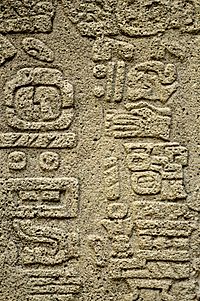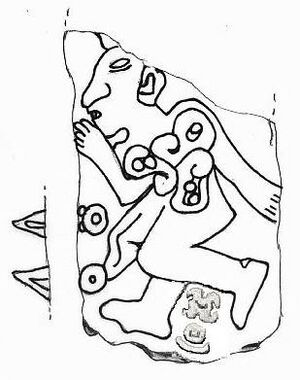Zapotec script facts for kids
Quick facts for kids Zapotec script |
|
|---|---|

Zapotec writing relief in the Site Museum of Monte Albán. Oaxaca, Mexico
|
|
| Type | Undeciphered |
| Spoken languages | Zapotec languages |
| Time period | 5th century BCE to 8th century CE |
| Note: This page may contain IPA phonetic symbols in Unicode. | |
The Zapotec script was a special way of writing used by the Zapotec culture in ancient Mesoamerica. It is one of the very first writing systems to appear in this region. The Zapotecs lived in what is now Oaxaca, Mexico. They built a powerful city called Monte Albán after the Olmec civilization became less powerful.
At Monte Albán and other Zapotec sites, archaeologists have found many stone carvings with this writing. These carvings often show pictures and symbols, called glyphs. Some of these symbols clearly show dates from their calendar. However, most of the Zapotec script is still a mystery. We cannot fully read it yet.
The Zapotec script was usually read in columns, from top to bottom. Experts believe it was less focused on sounds (like our alphabet) and more on whole words or ideas, compared to the later Maya script. It was likely created for an old version of the Zapotecan languages spoken today.
Contents
Where Did Zapotec Writing Begin?
For a long time, a stone carving from San Jose Mogote (called Monument 3) was thought to be one of the oldest examples of writing in Mesoamerica. It was made around the same time as some possible Olmec writing and before the Isthmian script.
However, we must remember that ancient people might have written on things that don't last, like wood, cloth, or deer hides. So, it's hard to know for sure where writing first started in Mesoamerica. What we do know is that ideas like calendars, numbers, and naming people by their birth dates were used widely in Mesoamerica a long time ago.
San Jose Mogote Monument 3
Monument 3, also known as the Danzante (which means "dancer"), is a famous stone from San Jose Mogote, Oaxaca. It is believed to have the earliest example of Zapotec writing. This stone was placed as a doorstep to an important building. It shows a carved image of a person who appears to be a captured warrior.
In the past, people thought these carvings showed dancers. But now, experts believe they show war prisoners who were captured and sacrificed. The symbols on the San Jose Mogote Danzante include drops of blood and a possible calendar day-name, "1 Earthquake." This monument was made before 500 BCE. Around that time, San José Mogote lost its power and came under the control of Monte Albán.
Zapotec Writing at Monte Albán
Early Monte Albán (500-200 BCE)
When Monte Albán became the most important city around 500 BCE, similar "danzante" stones were put up there. These stones are from the earliest time Monte Albán was settled. They might show leaders from other towns and villages that Monte Albán captured. Some of these captured leaders are even identified by name. More than 300 "Danzantes" stones have been found. You can see some of the best-preserved ones at the Monte Albán museum.
Middle Monte Albán (200 BCE - 250 CE)
Another type of carved stone can be found on Building J in the main plaza of Monte Albán. These are large carved slabs built into the walls. They are from a later period of Monte Albán. These stones show names of places, sometimes with more writing. Many of them have upside-down heads.
An archaeologist named Alfonso Caso was the first to suggest these were "conquest slabs." He thought they listed places that Monte Albán's rulers claimed to have conquered. Some of these places have been identified, and in one case, archaeologists have found proof that the Zapotecs did conquer that area. However, some of these identifications are still debated. It seems that the use of the Zapotec writing system started to decrease by the end of this period.
Later Monte Albán (250 - 700 CE)
During the Early Classic period (250-450 CE), writing at Monte Albán was mostly used for calendar dates, names of people, and names of places. Pictures and symbols were used for other messages. This trend continued, and eventually, the Zapotec writing system was used less and less.
By the later period (around 450-700 CE), the carvings showed a big change in style. While calendar information and names were still important, the way they were organized became less clear. This eventually led to the Zapotec script being abandoned.
How Zapotec Writing Spread
The Zapotec script spread across southwestern Mesoamerica. This might have happened because Monte Albán became very powerful, or because different groups of important people started to connect more. The Zapotec script reached as far west as the Pacific coast of Oaxaca and Guerrero. Most of these carvings are from 600 to 900 CE.
As the script spread, it was used by people who spoke different languages. It became more focused on showing whole words or ideas, and less on sounds. This change might also be linked to the rising importance of the city of Teotihuacán.
Some experts believe that Zapotec writing influenced other writing styles in the Isthmus of Tehuantepec and Chiapas. In the northwest, Zapotec writing mixed with ideas from Central Mexico to create the Ñuiñe script.
The Zapotec script seems to have stopped being used by the end of the Classic period. Most carvings were made before 700 CE, and by the 10th century, a new form of writing took its place. This new writing eventually led to the later Mixtec and Aztec writing systems. It is possible that these new systems were influenced by the older Zapotec writing.
See also
 In Spanish: Escritura zapoteca para niños
In Spanish: Escritura zapoteca para niños


